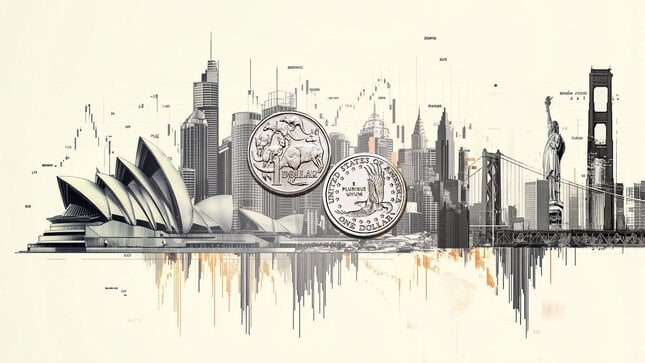AUD/USD Exchange rate
Editors’ Picks

AUD/USD flat lines around 0.6700, awaits China's inflation data
AUD/USD consolidates around 0.6700 in the Asian session on Friday as traders opt to wait on the sidelines ahead of the latest inflation figures from China. Meanwhile, the focus remains on the US NFP report, which will influence the Fed's rate-cut path and drive the US Dollar. In the meantime, the divergent Fed-RBA outlooks could act as a tailwind for the currency pair. At current levels, spot prices remain on track to end the week on a flattish note.

USD/JPY reacts little to Japan's Household Spending data as focus remains on US NFP
USD/JPY is trading with a positive bias for the fourth consecutive day, hovering near the top end of its weekly range, at around 157.00. Meanwhile, an unexpected rise in Japan's Household Spending keeps the door open for further policy tightening by the BoJ. This marks a significant divergence compared to dovish Fed expectations, which acts as a headwind for the US Dollar and might cap the currency pair ahead of the crucial US NFP report, due later today.

Gold edges lower as bulls opt to wait for the crucial US NFP report
Gold struggles to capitalize on the previous day's goodish move up from the vicinity of the $4,400 mark and attracts some sellers during the Asian session on Friday as bulls seem reluctant ahead of the US NFP report. The critical US employment details will offer more cues about the Fed's rate-cut path, which, in turn, will influence the US Dollar price dynamics and provide a fresh impetus to the non-yielding bullion. In the meantime, dovish Fed expectations and rising geopolitical tensions might continue to act as a tailwind for the XAU/USD.

XRP slides as institutional and retail demand falters
Ripple (XRP) is trading down for the third consecutive day on Thursday amid escalating volatility in the cyrptocurrency market. After peaking at $2.41 on Tuesday, its highest print since November 14 amid the early-year rally, XRP has quickly ran into aggressive profit-taking.

2026 economic outlook: Clear skies but don’t unfasten your seatbelts yet
Most years fade into the background as soon as a new one starts. Not 2025: a year of epochal shifts, in which the macroeconomy was the dog that did not bark. What to expect in 2026? The shocks of 2025 will not be undone, but neither will they be repeated.
Majors
Cryptocurrencies
Signatures
AUD/USD
The AUD/USD currency pair, commonly known as the “Aussie”, represents how many US dollars (the quote currency) are needed to purchase one Australian dollar (the base currency). Alongside with the New Zealand Dollar (NZD) and the Canadian Dollar (CAD), the AUD is considered a commodity currency due to Australia’s significant exports of raw materials such as precious metals, oil and agricultural products.
The Reserve Bank of Australia (RBA) has historically maintained higher interest rates compared to other industrialized nations. Combined with the relatively high liquidity of the AUD, this has made the AUD attractive for carry traders looking for a currency with higher yields.
HISTORIC HIGHS AND LOWS FOR AUD/USD
- All-time records: Max: 1.4875 on February 1974 – Min: 4851 on March 2001
- Last 5 years: Max: 0.8007 on 25/02/2021 – Min: 0.5509 on 19/03/2020
* Data as of December 2024
INFLUENTIAL ASSETS FOR THE AUD/USD
- Currencies: The Japanese Yen (JPY) and the Chinese Yuan (CNY), as Japan and China are the most significant trading partners of Australia. Other relevant currency pairs include: EUR/USD, GBP/USD, USD/JPY, USD/CHF, NZD/USD and USD/CAD.
- Commodities: Gold, Iron Ore and Natural Gas.
- Bonds: GACGB10 (Australia Government 10-year Bond Yield), and T-Note 10Y (10-year United States Treasury note).
INFLUENTIAL ORGANIZATIONS AND PEOPLE FOR THE AUD/USD
- Reserve Bank of Australia (RBA) is Australia's central bank, deriving its functions and powers from the Reserve Bank Act 1959. Its primary duty is to contribute to currency stability, full employment and the economic prosperity and welfare of the Australian people. The RBA achieves this by setting the cash rate to meet a medium-term inflation target of between 2% and 3%, maintaining a strong financial system and efficient payment infrastructure and issuing the nation's banknotes.
- The Federal Reserve (Fed) is the central bank of the United States (US) and it has two main targets: to maintain the unemployment rate at its lowest possible levels and to keep inflation around 2%. The Federal Reserve System's structure is composed of the presidentially appointed Board of Governors and the partially appointed Federal Open Market Committee (FOMC). The FOMC organizes eight scheduled meetings in a year to review economic and financial conditions. It also determines the appropriate stance of monetary policy and assesses the risks to its long-run goals of price stability and sustainable economic growth. The FOMC Minutes, which are released by the Board of Governors of the Federal Reserve weeks after the latest meeting, are a guide to the future US interest-rate policy.
- Michele Bullock is an Australian economist and the current Governor of the Reserve Bank of Australia. She assumed the role in September 2023 and is the first woman to hold the position. She is the Chair of the Reserve Bank Board, Payments System Board and Council of Financial Regulators. Prior to her current role, Bullock was the Deputy Governor of the RBA.
- Jerome Powell took office as chairman of the Board of Governors of the Federal Reserve System in February 2018, for a four-year term ending in February 2022. He was sworn in on May 23, 2022, for a second term as Chairman ending May 15, 2026. Born in Washington D.C., he received a bachelor’s degree in politics from Princeton University in 1975 and earned a law degree from Georgetown University in 1979. Powell served as an assistant secretary and as undersecretary of the Treasury under President George H.W. Bush. He also worked as a lawyer and investment banker in New York City. From 1997 through 2005, Powell was a partner at The Carlyle Group.